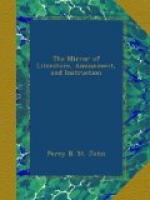[12] This very ingenious method
of tranferring printed patterns
to biscuit ware was invented
at the Porcelain works at
Worcester.
The finest patterns are applied after the glazing has been completed, by taking the impressions from the copperplate on a flexible strap covered with a strong gelatinous mixture of glue and treacle. This strap is then pressed on the ware, and gives the impression in glue, the colouring powder is then dusted over it, and a sufficient portion adheres to the damp parts to give the pattern, after having been again in the furnace. The more elaborate patterns on earthenware, and all those on porcelain, are finished by penciling in.
* * * * *
SPIRIT OF THE PUBLIC JOURNALS
* * * * *
THE WAVERLEY NOVELS.
Heroines.
The female characters in the Waverley Novels are touched with much grace and spirit, though they are not, upon the whole, brought so vividly to our minds as the men,—probably because they are more ideal. Such they must necessarily be. The course of woman’s existence glides comparatively unobserved in the under-current of domestic life; and the records of past days furnish little note of their condition. Few materials are available from which the historical novelist can deduce an accurate notion of the relative situation of women in early times. We know very little either of the general extent of their cultivation and acquirements, or of the treatment which they received from men. On the latter point, we must not allow ourselves to be deceived by the poetical effusions of gallantry, and the false varnish of chivalrous devotion. It is to be feared that the practice of the days of chivalry was much at variance with its professions; and that women were degraded, as we always find them wherever civilization has made little progress. It was by command of Edward I. of England, the Mirror of Chivalry, one of the bravest knights in the host of the Crusaders, that two of the noblest ladies in Scotland were hung up in iron cages, exposed like wild beasts to the view of the populace. Facts like this mark the standard of public feeling, and may teach us that there was little real consideration for women in those times;—and where that is not found, there can be little refinement. Scantiness of information, and the necessity of assimilating to modern tastes a picture which, if it could have been obtained, would probably have been disagreeable, has obliged the Author of Waverley to draw much from the resources of his poetical mind in the depicting of female character. And wisely has he so done; for we regard many of the females in his tales only as beautiful and poetical creations; and we are gratified without being deceived. We find no fault with him for having made his Minna and Brenda beings such as the daughters of a Shetland Udaller, nearly a century




